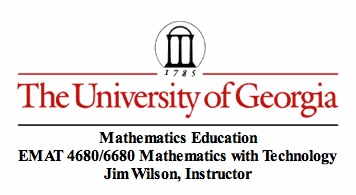
Exploring Parametric Equations
By: Sydney Roberts
For this
exploration, we will be investigating parametric equations of the form
![]()
LetŐs start by
investigating what will happen when a and b vary at
the same rate (are defined as the same constant) from 0 to 10. We can see that
as this constant is around 1, we have a complete circle that is formed.


After n
reaches 1, we can assume that the circle continues to loop around. Hence,
allowing n to vary from 0 to 10 will allow for 10 completed revolutions to be
made starting from t=0 and moving counterclockwise.
Now letŐs
consider what happens if we vary a and b (again at the
same rate) from -10 to 0. This time, as n approaches 0, the circle seems to
ŇunwindÓ counterclockwise from t=0. Therefore, it seems that the negative
values cause the parametric circle to start with 10 (because we started at -10)
revolutions, and then unwind in a counterclockwise motion.
The
interesting investigations come from when a and b are
not the same constant. Consider some examples below and try to make your own
conjectures.












At this
point you should start to see a pattern form that deals with the ratio of b to
a. We see that the parametric curves tend to intersect and form Ňloops.Ó It
appears as if the number of these loops is
![]() . However, we have only looked at cases
where a ˛ b. What happens if b ˛ a?
. However, we have only looked at cases
where a ˛ b. What happens if b ˛ a?
Again, look at
the following examples.












Here, the
relationship is harder to see, but there are some conclusions we can draw:
á
If
![]() is an odd integer, then the parametric
curve is non-intersecting
is an odd integer, then the parametric
curve is non-intersecting
á
If
![]() is an even integer, then the parametric
curve greatly resembles the previous explorations of looking at when a ˛ b
except this time, the parametric curve is forming on the y axis instead of the
x axis.
is an even integer, then the parametric
curve greatly resembles the previous explorations of looking at when a ˛ b
except this time, the parametric curve is forming on the y axis instead of the
x axis.
For further
exploration, look at these animations for different relationships between a and b.
